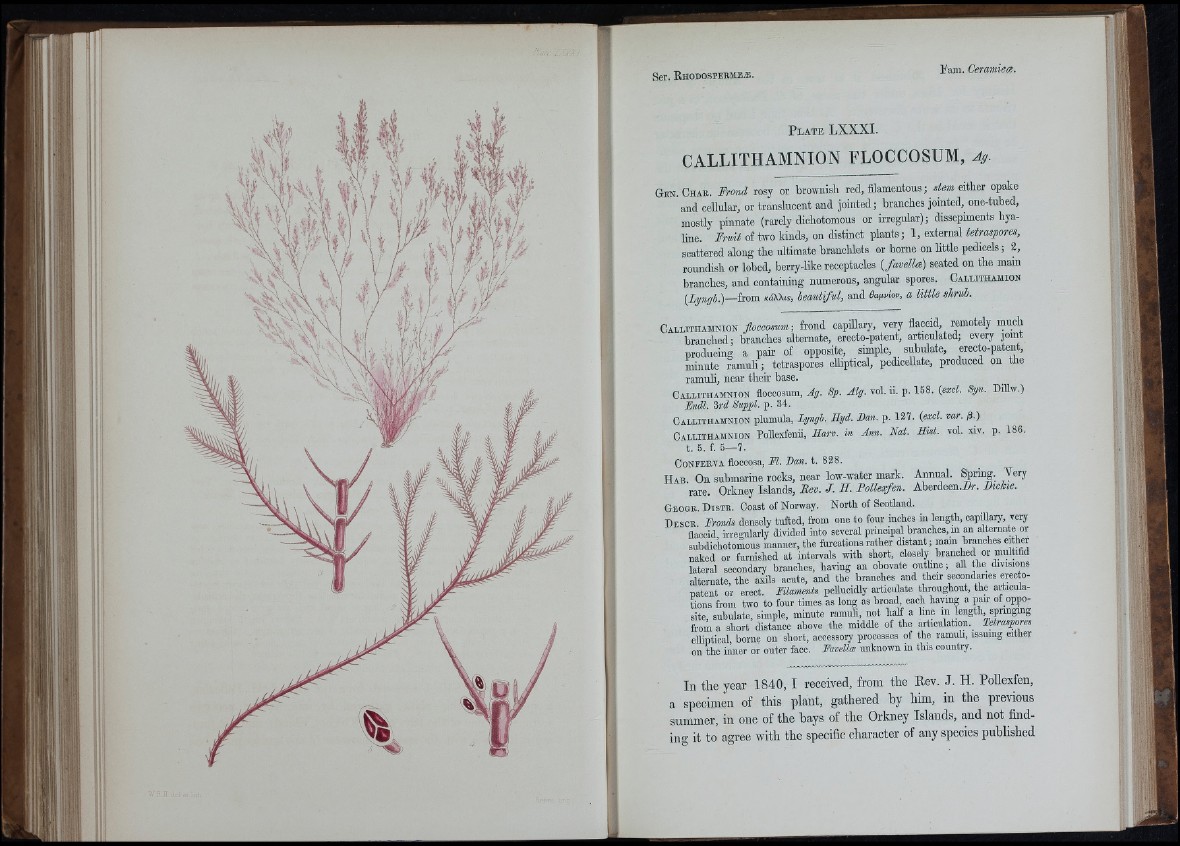
P l a t e LXXXI.
CALLITHAMNION LLOCCOSUM, Jg.
G e n . Chae. Frond rosy or brownish red, filamentous ; stem either opake
and cehular, or translucent and jointed; branches jointed, one-tubed,
mostly pinnate (rarely dichotomous or irregular); dissepiments hyaline.
F ru it of two kinds, on distinct plants ; 1, external tetraspores,
scattered along the ultimate branchlets or borne on little pedicels; 2,
roundish or lobed, berry-like receptacles [fav ellæ] seated on the mam
branches, and containing numerous, angular spores. Callithamion
[ L y n g l)— Im m koKXis, beautiful, and eagviov, a little shrub.
Callithamnion floccosum-, frond capillary, very flaccid, remotely much
b ran ch ed ; branches alternate, erecto-patent, articulated; every joint
producing a pair of opposite, simple, subulate, erecto-patent,
minute r am u h ; tetraspores elhptioai, pedicellate, produced on th e
ramuh, near their base.
C a l l it h a m n io n floccosum. Ag. Sp. Alg. vol. ii. p. 1 5 8 . [excl. Syn. Dillw.)
Fndl. 3rd Suppl. p. 34.
Ca l l it h a m n io n plumula, Lyngl. Hyd. Dan. p. 127. [excl. var. ¡3.)
Ca l l it h a m n io n PoUexfeuii, LLarv. in Ann. Nat. Hist. vol. xiv. p. 186.
t. 5. f. 5— 7.
CoNFBBVA floccosa, FI. Dan. t . 8 2 8 .
H a b On submarine rocks, near low-water mark. Annual. Spring. Very
rare. Orkney Islands, Rev. J. H . FoUexfen. Aberdeen./r. BieJcie.
G e o g b . D i s t b . Coast of Norway. North of Scotland.
D e s c e . Fronds densely tufted, from one to four inches in length, capiUary. very
flaccid, irregularly divided into several principal branches, m an alternate or
subdichotomous manner, the furcations rather distant ; mam branches eithei
naked or furnished at intervals with short, c lo s e ly branched or multifid
lateral secondary branches, having an obovate outline; all the divisions
alternate, the axüs acute, and the branches and their secondaries erec o-
natent or erect. Filaments peUucidly articidate throughout, the articulations
from two to four times as long as broad, each haying a pan of opposite
subulate, simple, minute ramuli, not half a line in length, sprmgmg
from a short distance above the middle of the articulation.^ Tfraspores
eUiptical, borne on short, accessoi-y processes of the ramuh, issuing either
on the inner or outer face. Eavelloe unknown in this country.
In the year 1840, I received, from the Rev. J. H. Pollexfen,
a specimen of this plant, gathered by him, in the previous
summer, in one of the bays of tbe Orkney Islands, and not finding
it to agree with the specific character of any species published
Ï !